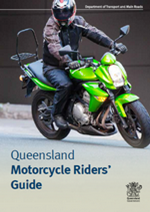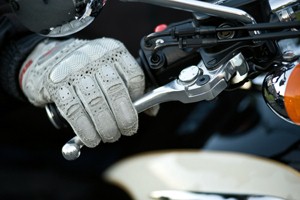Queensland Motorcycle Riders' Guide
 The Queensland Motorcycle Riders' Guide is a comprehensive one-stop reference handbook for all motorcyclists, whether you are new to riding, a regular rider or thinking of returning to ride. It covers a range of topics including licensing and registration, road rules, protective gear, safe riding techniques, how to cope with hazards, motorcycle maintenance, modifications, offences and current penalties.
The Queensland Motorcycle Riders' Guide is a comprehensive one-stop reference handbook for all motorcyclists, whether you are new to riding, a regular rider or thinking of returning to ride. It covers a range of topics including licensing and registration, road rules, protective gear, safe riding techniques, how to cope with hazards, motorcycle maintenance, modifications, offences and current penalties.
Motorcyclists have to adhere to the same Queensland Road Rules as other road users however, there are some laws that apply specifically to motorcycle riders and their pillion passengers. In addition, there are special rules for the class of licence you hold (learner, provisional and open).
The Queensland Motorcycle Rider’s Guide and the latest edition of Your Keys to Driving in Queensland provides up-to-date information about the Queensland licensing system, road rules and road safety messages.
Choosing the right motorcycle
Just because a motorcycle looks good, doesn't mean it's the best choice for your needs and your level of experience. Try out a few different motorcycles and get advice from experienced riders.
Remember a few basic rules:
- If you are a learner rider or hold a class RE motorcycle licence in Queensland, you are restricted to a motorcycle approved under the LAM Scheme.
- Your motorcycle must be roadworthy. Buying through a licensed dealer may be more expensive than buying privately, but will provide you with a warranty and guarantee of title.
- Make sure your motorcycle suits your build. You don't want one that's too high for you, so make sure you feel comfortable when you're sitting on it with the stands up. You'll also want to make sure you can push it easily without losing your balance.
Motorcycle maintenance checklist
You should check your motorcycle before every ride — your safety begins with your motorcycle. Routinely check and maintain your motorcycle to reduce your risk of injury and the risk of damage to your motorcycle. Before riding make sure you check:
- current registration
- registration plate is clearly displayed and securely attached
- working lights - including headlights, tail-light, brake light and indicators
- working brakes
- steering
- suspension
- working horn
- tyre pressure and tread depth (at least 1.5mm over the whole tyre surface)
- chain/drive belt guard.
Adjust the controls of the motorcycle so they are right for you. You should be able to reach all the controls easily without being cramped.
Before you ride
 No one can predict what will happen on the road, but you can put the odds in your favour if you make sure you and your motorcycle are in top condition before you set out.
No one can predict what will happen on the road, but you can put the odds in your favour if you make sure you and your motorcycle are in top condition before you set out.
Are you roadworthy?
Riding a motorcycle safely is more mentally and physically demanding than driving a car. Use this simple checklist to make sure you're up to it.
Don't ride if:
- you're tired or unable to concentrate
- your blood alcohol level is above the legal limit
- you are under the influence of illegal drugs or any medication that may affect your riding ability.
Think very carefully about riding if you:
- are not in the right frame of mind to be alert and careful
- haven't slept well
- are stressed
- feel unwell or emotionally upset.
Safe riding tips
Maintaining concentration
Your survival depends on concentration, anticipation and judgement.
You need to be aware of how your concentration is affected by your immediate environment, your health and/or physical condition, and your ability to process visual information. Fatigue, alcohol and drugs are just some things that can affect your concentration.
Speed management
Skilful riders manage their speed and road position to maintain a crash avoidance space around their motorcycle. To determine the crash avoidance space to the front of your motorcycle, you need to take into account two key factors – reaction time and response time.
Reaction time is the time you need to:
- see the information
- understand what it means
- decide on a response.
A rider who is fit, concentrating, alert and not affected by alcohol, drugs, fatigue or a distraction, will require about one and a half seconds to react to a sudden and unexpected change in traffic.
Response time is the time required for you to take action. You need a two second gap to react and respond to a situation in front of you. You may need even longer in poor conditions.
Remember, the faster you are travelling, the longer it takes to stop.
Positioning
Traffic and road situations are constantly changing and so does the safest position on the road. Skillful riders aim to be in the right place at all times. Generally you should position yourself on the road where you can see ahead and where you can be seen by other road users. Select a safe gap when turning, overtaking and changing lanes.
Riding techniques such as identifying vehicle blind spots and correct positioning, can improve your visibility to other road users. Don’t ride in the blind spots of other vehicles (behind and beside them). If you cannot see the external mirrors of the vehicle in front, the driver cannot see you.
Night riding
Riding at night is considerably more dangerous for motorcyclists. Take extra care when riding at night and apply safety measures, such as:
- Ensure you can be seen—check that your lights and indicators are working properly, and wear reflective or fluorescent clothing.
- Maximise your vision—avoid wearing dark, tinted or scratched eye protection, travel on well-lit roads, and use high beam (except within 200m of another vehicle).
- Give yourself time to respond — slow down to maintain at least 6 seconds of vision, and increase your crash avoidance space — you must be able to stop within the distance you can see.
- Last updated 24 August 2017

